Get ready, heroes! 2025 is shaking up the very ground beneath players' feet in Overwatch 2. Forget just learning new heroes; mastering the evolving battlefields is the real key to climbing those ranks. This year brings a whirlwind of change: brand new arenas, radical reworks of existing maps, the introduction of the chaotic Stadium mode with its unique layouts, and game-altering systems like Hero Bans and Map Voting. Understanding these shifts isn't just helpful – it's the difference between dominating a match and getting rolled back to spawn. These changes fundamentally alter how teams engage, control space, and execute strategies. Knowing the quickest flank on a reworked Suravasa, the optimal high ground on the new Aatlis Flashpoint map, or how to navigate the condensed chaos of a Stadium Push map like Dam provides a massive competitive advantage. Let's dive into the evolving world of Overwatch 2's maps and explore how to conquer them!
Shifting Sands: Flashpoint Reworks and the Arrival of Aatlis
The Flashpoint game mode, introduced in 2023 with Suravasa and New Junk City, has had a mixed reception, often criticized for map clutter, visual indistinctness (especially New Junk City), and the sheer distance between points making matches feel drawn out or snowbally. Recognizing this, Blizzard announced major reworks for both original Flashpoint maps slated for 2025, likely starting around Season 17 (July).
Suravasa & New Junk City Reworks (Expected Season 17 onwards)
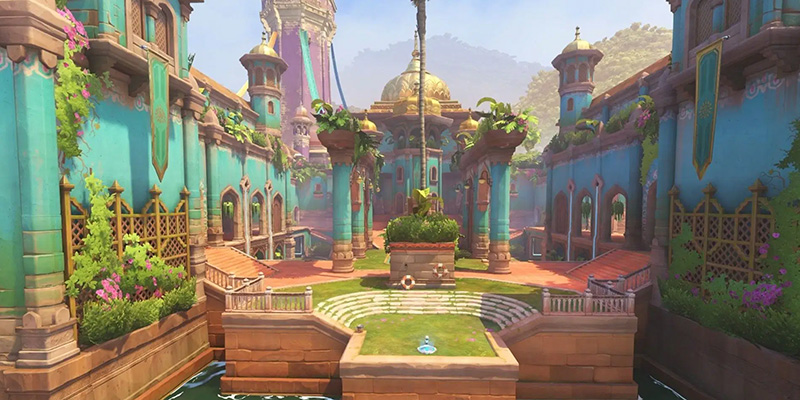
Layout Analysis (Anticipated Changes): Expect changes focused on improving navigation between the five capture points, potentially adjusting cover placements, clarifying sightlines, and maybe even tweaking point layouts themselves to create more engaging fights. The goal will likely be to reduce downtime and make rotations less punishing, while improving the visual language of each area, especially on New Junk City.
Key Sightlines & Position Control: Reworks might alter dominant high grounds or open/close sightlines near objectives. Controlling central areas that offer quick access to multiple potential next points will remain crucial.
Optimal Hero Selections: Depending on the changes, mobility heroes (Lucio, Tracer, Genji, D.Va, Ball) might become even more valuable if travel times remain significant, or less critical if paths are streamlined. Heroes excelling at controlling specific point types (e.g., brawl heroes for enclosed points, poke heroes for open ones) will still be important. Perks introduced in Season 15 could also shift viability based on new map geometry.
New Flanking Routes & Shortcuts: Reworks almost always introduce or modify flanking options. Expect potential new paths or adjustments to existing ones, impacting how teams approach points or defend against dives.
Defensive Setup Positions: Changes to cover and point layouts will necessitate new defensive strategies. Teams might find new strongholds or discover old ones are no longer viable.
Ultimate Usage Locations: Altered map geometry will create new high-value locations for ultimates like Earthshatter, Graviton Surge, or Blizzard.
Objective Strategy Adjustments: The core Flashpoint objective (capture 3 of 5 points) will remain, but reworks might influence the importance of winning the first point versus playing for map control anticipating the next spawn. Reduced travel time could make retakes easier.
Team Composition Recommendations: Comps might shift based on specific changes. More cover could favor brawl comps, while opened sightlines might benefit poke comps. Adaptability will be key post-rework.
Unique Environmental Interactions: Unlikely major changes here, but tweaks to existing elements (like Suravasa's water hazards) are possible.
Aatlis (Flashpoint - Expected Season 17)
Context: Aatlis is the brand-new Flashpoint map set to release in Season 17 (Late June/July 2025). Its arrival aims to inject much-needed variety into the Flashpoint map pool, which players felt was lacking.
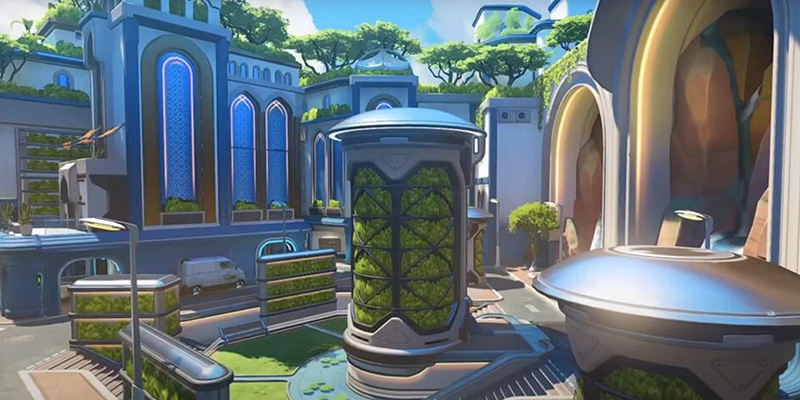
Layout Analysis: Currently, no specific layout details or concept art for Aatlis have been released. Given it's a Flashpoint map, it will inherently be large with five distinct capture points. Developers may have learned lessons from Suravasa and New Junk City, potentially designing Aatlis with clearer navigation, more distinct objective areas, and perhaps a different environmental theme compared to the Indian temple city or Australian wasteland settings. Some leaks connect the name "Arakko" (mutant Mars from Marvel) to potential future maps in other games, but this is highly speculative and likely unrelated to Overwatch's Aatlis.
Key Sightlines & Position Control: Unknown, but expect a mix of open areas and tighter spaces around the five points, typical of Flashpoint design. Identifying the central "hub" areas offering quick rotations will be vital.
Optimal Hero Selections: Mobility will likely remain important for traversing the large map. Hero selection will depend heavily on the specific design of the five points – favoring brawl, poke, or dive comps accordingly. Freja, the Season 16 DPS hero with high mobility, might find Aatlis a favorable playground.
When playing Flashpoint maps, especially the upcoming Aatlis, these heroes offer superior mobility that can help your team control the map more effectively:
- Lucio: Speed boost makes him essential for quick rotations between distant points
- Tracer: Blinks and recall allow for rapid point contesting and scouting
- D.Va: Boosters provide both vertical and horizontal mobility
- Wrecking Ball: Unmatched map traversal with grapple and roll
- Freja: The new Season 16 DPS with high mobility toolkit
New Flanking Routes & Shortcuts: As a new map, discovering and mastering flank routes will be a race among players. Expect multiple paths connecting the objective areas.
Defensive Setup Positions: Teams will need to quickly identify the strongest defensive positions around each of the five potential capture points.
Ultimate Usage Locations: Identifying high-impact ultimate spots near each objective will be crucial for both attack and defense.
Objective Strategy Adjustments: Standard Flashpoint strategy applies: capture three points first. However, Aatlis' specific layout might favor certain rotation patterns or make contesting specific points more or less advantageous.
Team Composition Recommendations: Highly speculative. Balanced comps with good mobility and adaptability are usually safe bets on new, large maps.
Unique Environmental Interactions: Unknown. Depends entirely on the map's theme and design.
Renovating the Classics & Peeking into the Future
Beyond Flashpoint, Blizzard continues its efforts to refresh older maps and is already teasing battlegrounds set for late 2025 or early 2026.
Classic Map Revamps (Ongoing/Unspecified Dates)
Context: Alongside the Flashpoint map reworks, Blizzard confirmed they are working on "major reworks to another batch of classic maps". This follows the pattern set in late 2024 (Season 13) which saw significant changes to Dorado, Havana, Circuit Royale, and Numbani. The goal is typically to improve map flow, adjust cover and sightlines for the 5v5 environment, and address long-standing player frustrations. Data gathered from the upcoming Map Voting system will also inform which maps get prioritized for reworks.
- Maps frequently disliked or avoided in Map Voting
- Older maps that might still have awkward chokes or sightlines in 5v5 (potentially Escort or Hybrid maps, as Push and Control have received more recent additions/attention)
- Repurposing assets from removed maps like Paris (teased as a Push map for Stadium) or Horizon Lunar Colony into new layouts or modes, though this is less of a "rework" and more of a "reimagining"
- Maps mentioned in past developer blogs as needing adjustments, like Rialto or Gibraltar (though Gibraltar also got a Stadium variant, Dam)
Analysis: This ongoing process reflects a commitment to map health and adaptation. The shift to 5v5 fundamentally changed how space is controlled, demanding more cover and potentially less reliance on hard chokepoints held by double shields. These reworks aim to align older maps with modern gameplay philosophies.
Strategic Impact: Highly dependent on the specific map and changes. Adjusting a single doorway, adding a small piece of cover, or changing a health pack location can significantly alter common strategies, hero viability, and ultimate effectiveness on a map.
Future Battlefields (Post-Season 19 - Late 2025/Early 2026)
Blizzard has already unveiled concept art for two entirely new maps planned for release after Season 19 (likely landing in late 2025 or early 2026).
Atlantic Arcology
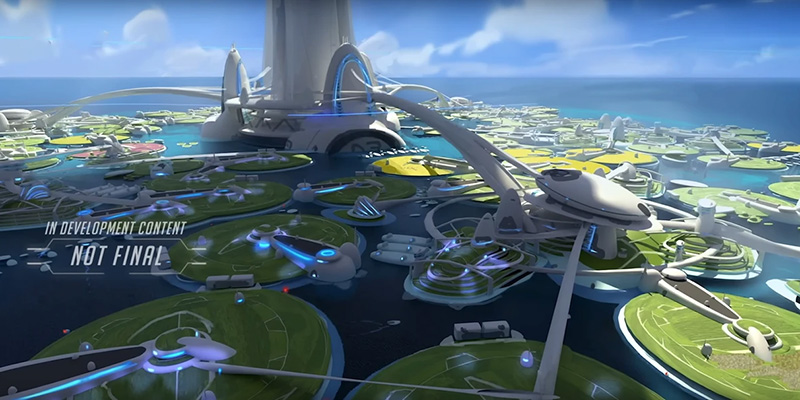
Concept & Lore: This confirmed map is an independent, self-sustaining scientific and ecological city located in the Atlantic Ocean, run by The Collective, an organization Lifeweaver is associated with. Teased through in-game posters (Numbani airport, Midtown hyper-rail) and voicelines, concept art depicts a stunning, massive central sea spire made of "durovidro" (ultrahard sea glass) extending both above and deep below the ocean surface, surrounded by artificial islands. It features advanced, clean technology, hyper-rail connections, landing platforms, internal plazas, research facilities, hydroponic gardens, and clear surrounding waters with coral farms. While it has underwater sections, it's not depicted as a fully submerged city like the fan-concept Talantis.
Layout Speculation: The design screams verticality. Expect multi-level engagements both inside the spire's vast interiors (plazas, labs, transport hubs) and on exterior platforms and bridges connecting the structures. The use of glass could create unique sightlines. Water might feature as an environmental hazard or aesthetic element. The game mode is currently unknown.
Strategic Implications (Speculative): Control of high ground will likely be paramount. The mix of potentially open exterior spaces and complex interiors suggests a need for adaptable team compositions. Heroes with strong vertical mobility (Pharah, Echo, Winston, Genji, Freja, potentially Lifeweaver himself) could excel. Unique environmental factors, if present, could create map-specific strategies.
Tokyo
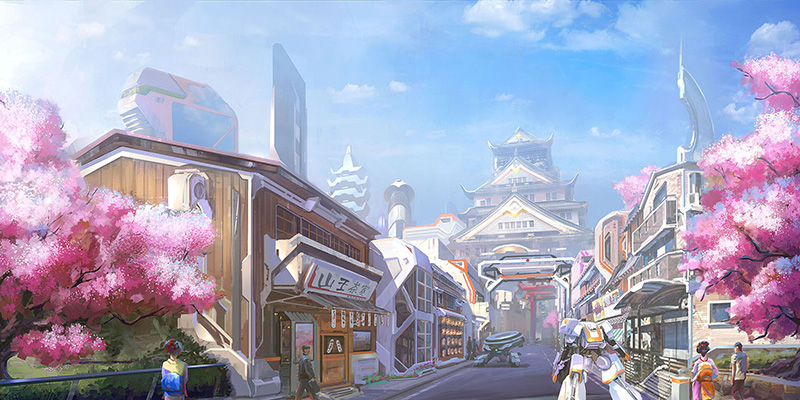
Concept & Lore: Also confirmed with concept art, this map presents a futuristic, high-tech vision of Tokyo's metropolitan landscape. This differentiates it from existing Japanese maps like Hanamura, Hanaoka, and Kanezaka, which showcase more traditional or residential areas (though geographically related). It naturally connects to the lore of heroes like Genji, Hanzo, and Kiriko. There's speculation it might visually tie into the streetwear designs featured in the RED Tokyo Tower collaboration merchandise, but this is unconfirmed.
Layout Speculation: The concept art suggests a dense urban environment dominated by skyscrapers, neon lights, and advanced technology. Expect a complex layout with narrow streets, potentially multi-level building interiors, open plazas, and significant verticality. Interactable elements like vehicles or dynamic signage are possibilities. Game mode is unknown.
Strategic Implications (Speculative): A likely mix of close-quarters combat within buildings and streets, contrasted with long sightlines available from windows and rooftops. Flanking routes through interconnected buildings or alleyways will be critical. Heroes adept at navigating complex vertical and horizontal spaces (Genji, Kiriko, Sombra, Tracer, Hanzo, Widowmaker) could thrive. Control of key rooftops or power positions overlooking objectives will be vital.
Welcome to the Stadium: A Whole New Arena
Season 16 (April 2025) didn't just bring a new hero and Hero Bans; it unleashed Stadium, a permanent new core game mode with its own rules, maps, and MOBA-inspired upgrade system. Understanding its unique map philosophy is crucial for success.
Stadium Map Philosophy & Modified Objectives
Stadium maps are intentionally designed differently from standard Overwatch 2 maps. They are generally smaller, more compact, faster-paced, and often symmetrical, built to facilitate constant action within the mode's best-of-seven, shorter round structure. This design complements the default third-person perspective option and the round-based Powers and Items upgrade system.
The objectives themselves are modified versions of existing modes:
- Push: The robot travels approximately half the distance compared to standard Push maps. Fights are more concentrated, and losing control can be harder to recover from due to the shorter track.
- Control: Each map instance features only one capture point, and capture progress is significantly faster. This makes the initial fight and subsequent retakes incredibly high-stakes and rapid.
- Clash: Played on maps with three potential objective points, but the round ends once a team captures two points. This condenses the back-and-forth nature of standard Clash into quicker, decisive rounds.
Stadium Map Pool Overview
Stadium launched with a pool of nine maps, a mix of reworked existing locations and brand-new arenas, cycling through its modified Push, Control, and Clash objectives across the best-of-seven rounds.
| Stadium Map Name | Original Map Basis | Stadium Game Mode | Key Features/Changes |
|---|---|---|---|
| Dam | Watchpoint: Gibraltar | Push | Trimmed section (Redwood Dam area), shorter distance |
| Arena Victoriae/Gladius | New Map | Control | Symmetrical, tight sightlines/lanes, faster capture |
| Place Lacroix (Paris) | Paris | Push | Reworked for faster, lane-based play, shorter distance |
| Gogadora (Busan) | Busan | Control | New Stadium-specific area, faster capture |
| Colosseo | Colosseo | Push | Slimmed down, faster pace, shorter distance |
| Ilios Ruins | Ilios | Control | One-point setup, designed for aggressive brawls, faster cap |
| Hanaoka | Hanaoka | Clash | Requires tight timing, 2-point win condition |
| Throne of Anubis | Temple of Anubis | Clash | Reworked layout, 2-point win condition |
| Nepal | Nepal | Control | Faster capture (implied by general Control changes) |
Spotlight on Key Stadium Maps
Let's break down a few diverse examples from the Stadium rotation:
Dam (Push - based on Watchpoint: Gibraltar)
Layout: This map utilizes a condensed section of Watchpoint: Gibraltar, specifically the Redwood Dam area, repurposed for the fast-paced Stadium Push mode. Expect familiar Gibraltar aesthetics but a much shorter, more direct path for the robot.
Objective Strategy: With roughly half the push distance, the initial fight for the robot is even more critical than usual. Gaining early control and leveraging Stadium upgrades to snowball momentum is key. There's less room for error and fewer opportunities for full resets.
Positioning: High ground overlooking the robot's path remains vital, mirroring standard Gibraltar tactics, but the options will be more limited and contested due to the smaller map size. Choke points, though potentially fewer, will be intense and demand coordinated pushes or strong defensive holds.
Hero/Build Synergy: The constant fighting favors heroes with strong sustain or brawl capabilities. Tanks like Reinhardt or Junker Queen can excel at leading the charge. Damage heroes capable of sustained output, like Soldier: 76 (especially with healing/damage field builds), or close-range threats like Reaper, fit well. Stadium upgrades enhancing survivability (lifesteal, armor) or area-of-effect damage are particularly valuable.
Arena Victoriae (Control - New Map)
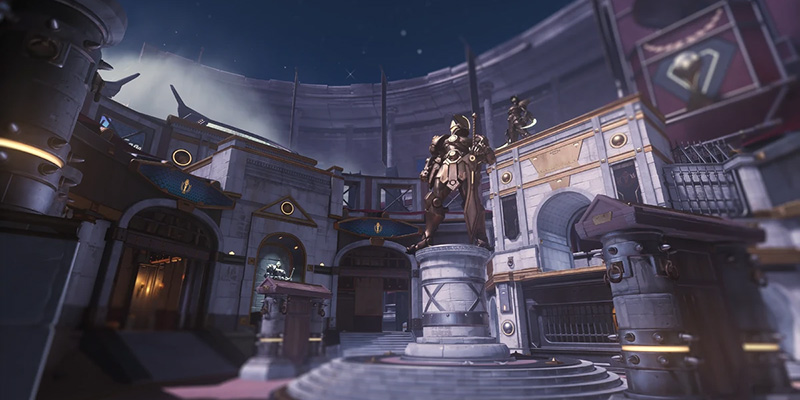
Layout: A brand-new arena built specifically for Stadium. Sources describe it as having clean symmetry and tight sightlines or lanes, suggesting a focused, perhaps gladiatorial-themed (based on speculation around the "Gladius" name) environment. It will feature a single, central control point.
Objective Strategy: The significantly faster capture speed for Stadium Control makes point control absolutely paramount. Fights will be decisive and quick flips common. There's little time for elaborate setups; teams need to contest immediately and effectively.
Positioning: The symmetrical design implies balanced approach routes. Tight sightlines favor close-to-mid-range engagements. Identifying and controlling any limited high ground or crucial corners overlooking the point will be essential for holding against rapid retake attempts.
These heroes excel in the tight confines of Arena Victoriae's close-quarters combat:
- Reinhardt: Shield and hammer provide unmatched area control
- Junker Queen: Commanding Shout gives team-wide survivability boosts
- Mei: Wall can split enemy team, Ice Block provides point presence
- Torbjörn: Turret offers additional point control
- Symmetra: Turrets slow enemies, teleporter enables surprise attacks
- Moira: AOE healing sustains the team in tight brawls
- Lucio: Speed boost gets team to point faster, sound barrier counters ultimates
Hero/Build Synergy: Brawlers who can dominate confined spaces (Reinhardt, Junker Queen, Mei) or heroes with strong point-hold tools (Torbjörn, Symmetra) should perform well. Supports providing substantial area healing (Moira, Lucio, Baptiste) will be crucial for sustaining the inevitable point brawl. Stadium builds focusing on burst damage for quick eliminations or enhanced survivability/sustain are key.
Place Lacroix (Paris) (Push - based on Paris)
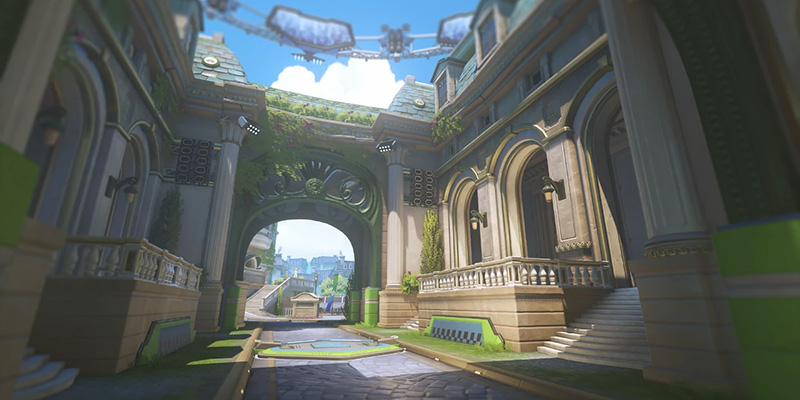
Layout: This map resurrects the aesthetic of the controversial Assault map, Paris, but completely reworks it for Stadium's faster, lane-based Push gameplay. Expect familiar Parisian architecture but a linear path designed for the robot, likely simplifying the original map's complex structure.
Objective Strategy: The "lane-based" description suggests a more straightforward Push path with potentially fewer flanking opportunities compared to standard maps like Colosseo or Esperança. Controlling this central lane and denying enemy progress through coordinated defense or aggressive pushes will be the primary focus. The shorter push distance still applies.
Positioning: Holding key corners, utilizing available high ground along the lane (if any exists in the rework), and maintaining sightlines on the robot's path are crucial. Teams need to be wary of any unexpected angles or shortcuts introduced in the rework.
Hero/Build Synergy: Heroes adept at controlling lanes through sustained fire or barriers (Orisa, Sigma, Soldier: 76, Ashe, Torbjörn) should be effective. Stadium builds enhancing barrier damage, turret strength, or long-range poke damage will be valuable. Mobility might be less critical if flanking is restricted, but still useful for quick rotations or chasing down stragglers.
Gogadora (Busan) (Control - based on Busan)
Layout: This isn't one of the standard Busan maps (Sanctuary, Downtown, MEKA Base) but a new, Stadium-exclusive area built within the Busan location. It will feature a single control point designed for the rapid pace of Stadium Control. Expect Busan's typical high-tech Korean aesthetic, possibly incorporating elements like the MEKA base or downtown architecture, but in a unique, condensed layout.
Objective Strategy: Like Arena Victoriae, the fast capture speed means the fight is entirely focused on controlling the single point. Understanding the specific cover, sightlines, and potential environmental hazards (Busan maps often feature pitfalls) of this new Gogadora area is critical for success.
Positioning: Quickly identifying the power positions is key. Where is the safest cover? What angles provide the best sightlines onto the point? Are there opportunities for environmental eliminations? Scouting in the third-person view can be particularly useful here.
Hero/Build Synergy: Given Busan's general tendency towards closer engagements, brawl or dive compositions often excel. Heroes like D.Va, Winston, Reinhardt, Reaper, Mei, and Lucio are traditionally strong picks. Stadium builds enhancing close-quarters damage, mobility for dives, or objective survivability will likely be effective. D.Va received specific Stadium item buffs against beams, potentially making her stronger here.
Game Changers: Hero Bans & Map Voting
Two major system changes introduced in 2025 fundamentally alter the strategic landscape before a match even begins: Hero Bans and Map Voting.
Hero Bans (Live in Competitive Season 16)
- Players can optionally select a "Preferred Hero" to communicate intent (this doesn't protect the hero from being banned)
- Teams enter a private communication phase to discuss bans
- Each team simultaneously bans up to two heroes using a Ranked Choice voting system (each player ranks up to three choices, first choice has highest weight)
- A maximum of two heroes per role can be banned across both teams' selections
- Players cannot see the enemy team composition or names during the ban phase
Strategic Implications: This system introduces significant pre-match strategy. Teams must coordinate to remove heroes that are either meta-dominant, particularly frustrating, synergize well on the upcoming map (once Map Voting is live), or directly counter their intended composition. The inability to see the enemy team prevents targeted bans against specific players in the lobby, promoting bans based on general meta and map strategy rather than personal vendettas. This forces players and teams to be more adaptable and proficient with a wider range of heroes, as relying on a single hero or strategy becomes riskier. The dynamic nature of bans means the available hero pool shifts slightly each match, potentially leading to more varied gameplay and preventing metas from becoming overly stale.
Map Voting (Coming Season 17)
- At the start of a match (before Hero Bans), players are presented with three map choices (It's currently unclear if these choices are always within the same game mode or can be mixed)
- Each player privately votes for one of the three maps
- The map is selected based on a weighted system, not a simple majority. Maps with more votes have a higher chance of being selected, but even maps with fewer votes have a possibility
- Blizzard will use data on frequently avoided maps to identify candidates for future reworks
Strategic Implications: This grants players significant agency in choosing their preferred battlegrounds. Teams can attempt to steer the selection towards maps that favor their strongest heroes, compositions, or playstyles. It adds another layer of pre-match consideration, as teams need to be prepared for multiple potential maps based on the voting options. The weighted system is crucial; it aims to prevent the community from only playing the 2-3 most popular maps, maintaining some level of map variety which is often a concern with voting systems. This balance between player choice and map pool diversity, combined with the feedback loop for reworks, makes Map Voting a potentially powerful tool for both players and developers.
The Grand Strategy: 2025 Map Tier List & Meta Forecast
The confluence of new maps, extensive reworks, the introduction of Stadium's unique environments, and the strategic layers added by Hero Bans and Map Voting creates a highly dynamic battlefield in 2025. The Perks system further complicates things, potentially making heroes viable on maps where they previously struggled by allowing customization of their kits mid-match. Hero Bans can negate map-specific strategies by removing key enablers, while Map Voting might concentrate play onto certain map types, influencing broader meta trends.
2025 Competitive Map Tier List (Standard Modes - As of May 2025 / Post-Season 16)
This tier list evaluates maps in the standard Competitive rotation based on perceived balance, strategic depth, and general player sentiment gathered from community discussions. Subjectivity is inherent, and tiers can shift with meta changes or future reworks. Stadium maps are excluded as they operate under different rules and balance considerations.
| Map Name | Game Mode | Tier | Justification |
|---|---|---|---|
| King's Row | Hybrid | S | Widely considered highly balanced, strong thematic design, supports various compositions and strategies. |
| Lijiang Tower | Control | S | Three distinct, well-regarded points offering varied engagement types; generally balanced. |
| Esperança | Push | A | Generally considered one of the better Push maps, complex layout with flank routes, visually appealing. |
| Blizzard World | Hybrid | A | Unique theme, offers distinct phases with different strategic demands, generally balanced choke points. |
| Oasis | Control | A | Diverse points (Jump Pad, Traffic, Gardens) requiring different approaches, visually distinct. |
| Ilios | Control | A | Classic Control map, distinct points (Well, Lighthouse, Ruins), environmental kill potential adds flavor. |
| Eichenwalde | Hybrid | B | Strong theme, but Point A choke can be notoriously difficult; later points offer more dynamic play. |
| Route 66 | Escort | B | Classic Escort map, Point A defense can be strong, long sightlines favor hitscan later on. |
| Circuit Royal | Escort | B | Long sightlines throughout, heavily favors poke/sniper comps, can feel one-dimensional at times. |
| New Queen Street | Push | B | First Push map, relatively straightforward layout compared to Esperança, can feel snowbally. |
| Runasapi | Push | B | Visually interesting, but Push mode itself still divisive; map layout complexity can be confusing. |
| Junkertown | Escort | C | Point A often feels very attacker-favored, long open sightlines dominate later stages, polarizing. |
| Suravasa | Flashpoint | C | Visually appealing, but Flashpoint mode issues (travel time, potential snowballing) persist pending rework. |
| New Junk City | Flashpoint | C | Suffers from Flashpoint issues plus complaints of visual clutter and confusing layout, pending rework. |
| Aatlis | Flashpoint | TBD | Not yet released (Expected Season 17) |
| Classic Reworks | Various | TBD | Impact depends on specific map and changes. |
Predictions: The Future of Overwatch 2's Environments
Short-Term (Rest of 2025)
The immediate future promises significant meta turbulence. Players will grapple with optimizing Perks on different maps, strategizing around Hero Bans, and leveraging Map Voting. The reception of the Suravasa/New Junk City reworks and the new Flashpoint map Aatlis will be critical for the mode's future. Stadium's popularity and its distinct map design might subtly influence player preferences and expectations for core modes, potentially increasing demand for faster-paced or more action-oriented map designs.
Long-Term (Beyond 2025)
The introduction of Map Voting provides Blizzard with invaluable data on player preferences, likely leading to more targeted and impactful map reworks in the future. The arrival of Atlantic Arcology and Tokyo will introduce fresh aesthetics and potentially novel gameplay mechanics tied to their unique environments (verticality, density, potential water elements). While purely speculative based on surveys, there's always a possibility of more experimental map features like dynamic weather or destructible environments being revisited down the line. The overarching trend established in 2025 is one of continuous evolution; map design, alongside core systems like Perks and Bans, is clearly intended to be an iterative process, constantly refined based on data and player feedback. Expect the battlefields of Overwatch 2 to keep changing.
Conclusion: Dominate the Map, Dominate the Match
The landscape of Overwatch 2 in 2025 is more dynamic and strategically complex than ever before. New maps like Aatlis, Atlantic Arcology, and Tokyo promise fresh challenges, while reworks breathe new life (or address old frustrations) into familiar territory. The introduction of Stadium brings an entirely new philosophy to map design, emphasizing speed and constant action. Layered on top of this, Hero Bans and Map Voting grant players unprecedented influence over the battlefield before the first shot is even fired.
Mastering Overwatch 2 in this era requires more than just mechanical skill and hero knowledge. It demands map mastery – an intimate understanding of layouts, sightlines, flanks, and objective nuances across an ever-evolving pool of arenas. Adaptability is paramount. Players and teams who dedicate themselves to learning the intricacies of new and reworked maps, mastering the unique demands of Stadium arenas, and strategically utilizing the Hero Ban and Map Voting systems will undoubtedly find themselves with a significant competitive edge.

